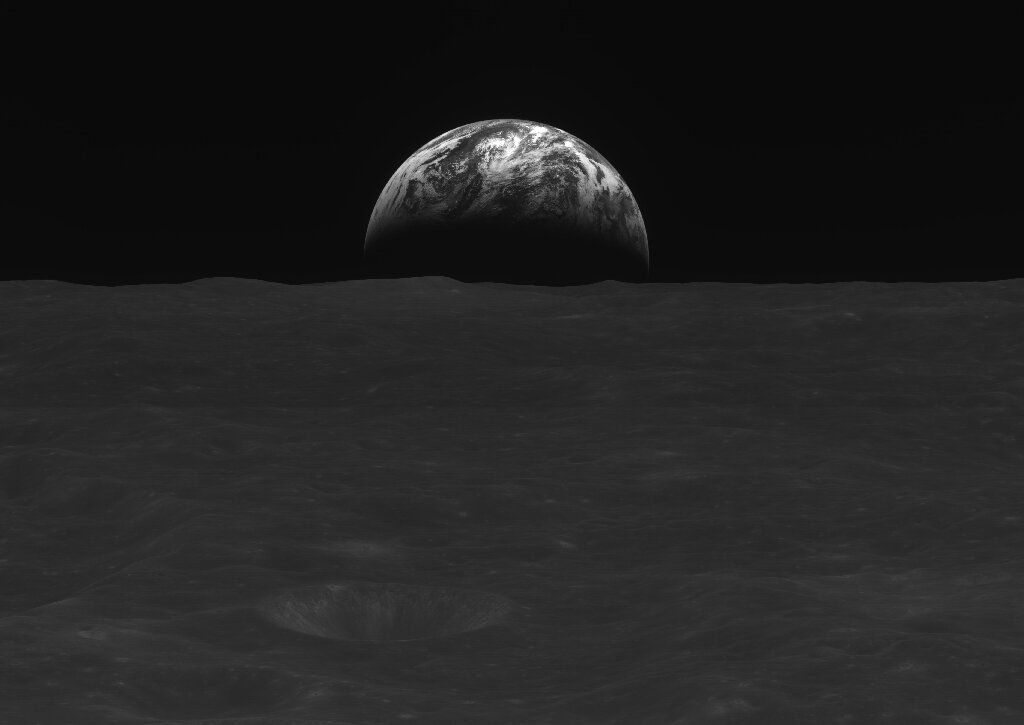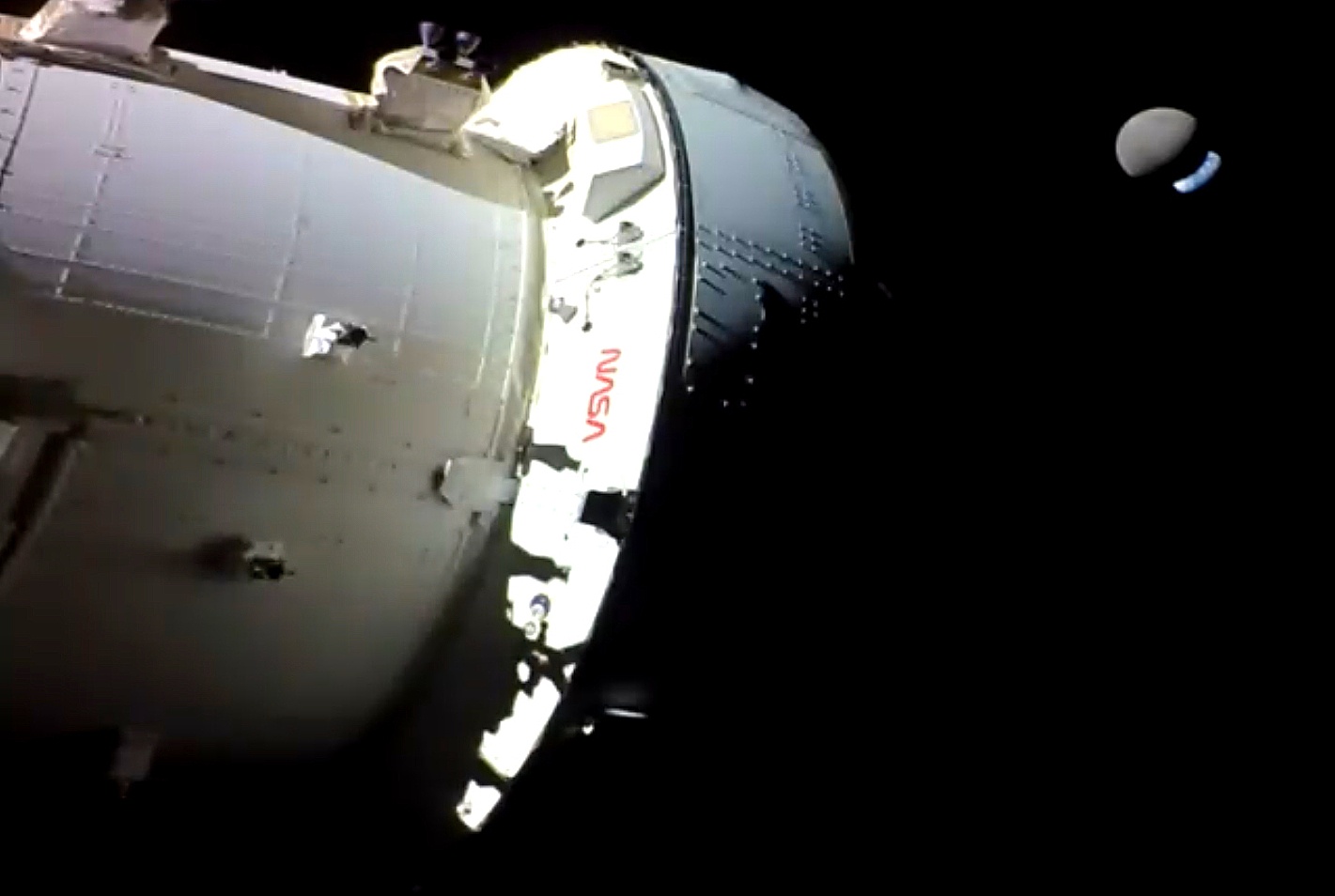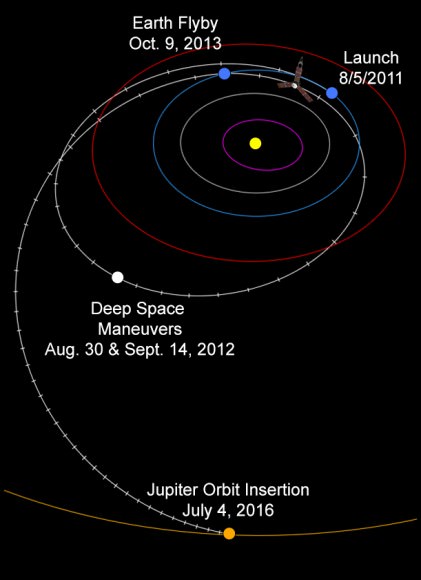The origins of the Moon have been the cause of many a scientific debate over the years but more recently we seem to have settled on a consensus. That a Mars-sized object crashed into Earth billions of years ago, with the debris coalescing into the Moon. The newly formed Moon drifted slowly away from Earth over the following eons but a new study suggests some surprising nuances to the accepted model.
Continue reading “When Earth Danced with Polar Moons”South Korea’s Danuri Mission Sends Home Pictures of the Earth and Moon
The Korea Aerospace Research Institute (KARI) both ended 2022 and started 2023 on a very high note as its first-ever lunar orbiter, Danuri, sent back black-and-white images of the Earth with the Moon’s surface in the foreground that were photographed between December 24 and January 1, KARI announced in a January 3rd statement. Both the images and videos were taken less than 120 kilometers (75 miles) above the Moon’s surface, and will be “used to select potential sites for a Moon landing in 2032,” KARI added in the statement.
Continue reading “South Korea’s Danuri Mission Sends Home Pictures of the Earth and Moon”OK, Artemis. Now You’re Just Showing Off. A Stunning View of the Moon Eclipsing Earth From the Orion Spacecraft
Have you ever seen a lunar eclipse of the Earth from the far side of the Moon? Now we have.
On Monday (November 28, 2022) NASA’s Orion spacecraft streamed back live video showing the Earth and Moon right next to each other, followed by a stunning view of the Moon eclipsing the Earth.
What a time to be alive! Image editor Kevin Gill might have said it best:
Continue reading “OK, Artemis. Now You’re Just Showing Off. A Stunning View of the Moon Eclipsing Earth From the Orion Spacecraft”Lucy Took This Picture of Earth as it was Making its Gravity Assist Maneuver
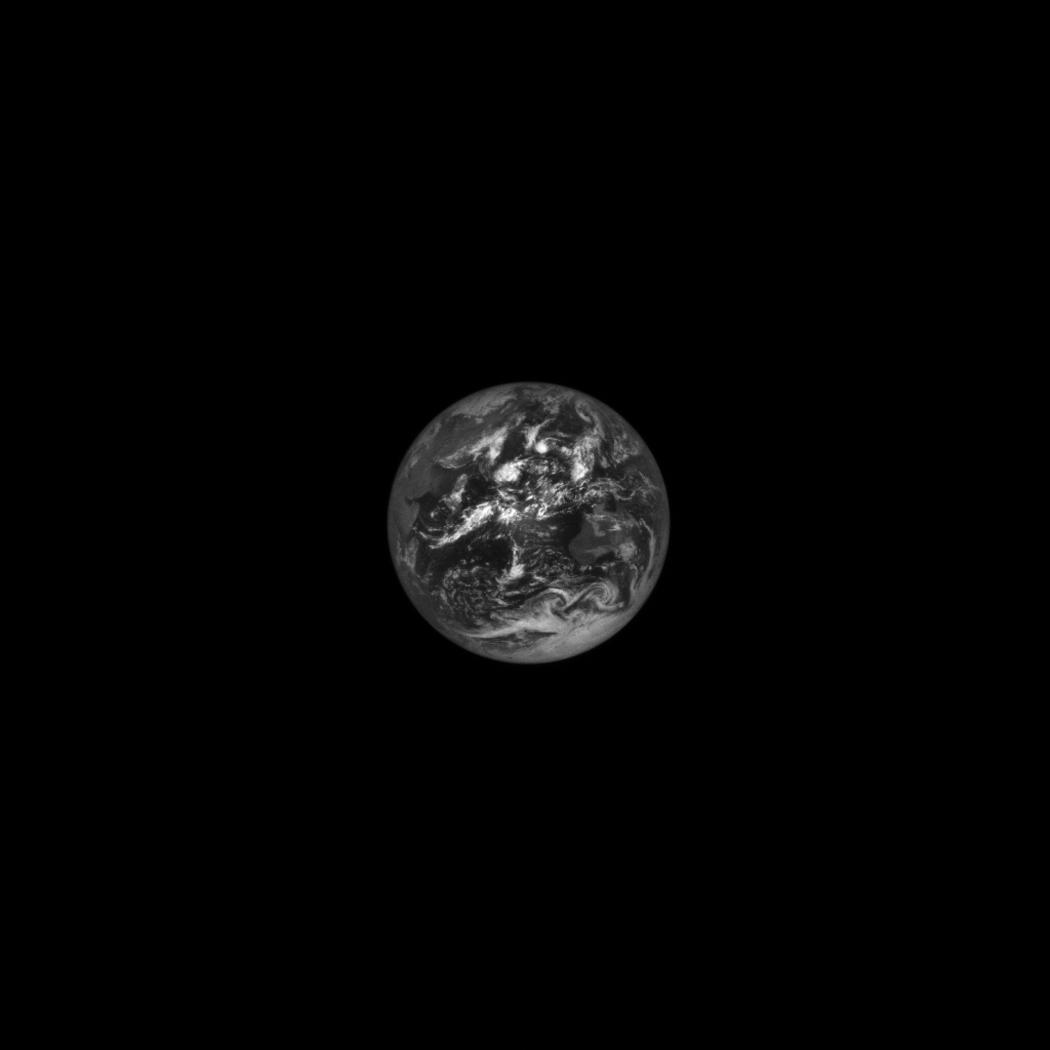
We may take it for granted, but every day we receive picture postcards from the robotic travelers we have sent out to explore our Solar System. Usually, we get to see faraway planets, moons, asteroids, or comets. But sometimes we get to see ourselves.
The Lucy spacecraft took a couple of amazing images of our home planet as the spacecraft was approaching Earth for the first of three slingshot gravity assists on its way out to explore the Trojan asteroids along Jupiter’s orbit.
Continue reading “Lucy Took This Picture of Earth as it was Making its Gravity Assist Maneuver”What is the Maximum Number of Moons that Earth Could Have?
In a recent study published in Earth and Planetary Astrophysics, a team of researchers from the University of Texas at Arlington, Valdosta State University, Georgia Institute of Technology, and the National Radio Astronomy Observatory estimated how many moons could theoretically orbit the Earth while maintaining present conditions such as orbital stability. This study opens the potential for better understanding planetary formation processes which could also be applied to identifying exomoons possibly orbiting Earth-like exoplanets, as well.
Continue reading “What is the Maximum Number of Moons that Earth Could Have?”70 Million Years Ago, Days Were 30 Minutes Shorter, According to this Ancient Clam
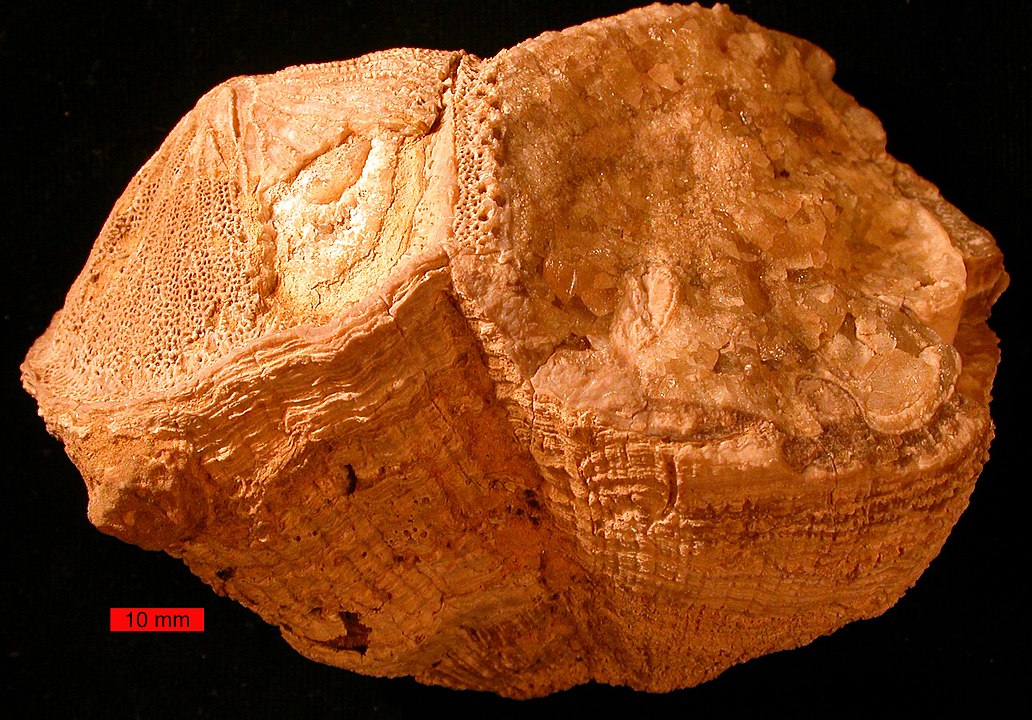
Has humanity been doing it all wrong? We’re busy staring off into space with our futuristic, ultra-powerful telescopes, mesmerized by ethereal nebulae and other wondrous objects, and trying to tease out the Universe’s well-kept secrets. Turns out, humble, ancient clams have something to tell us, too.
Continue reading “70 Million Years Ago, Days Were 30 Minutes Shorter, According to this Ancient Clam”When the Impact that Created the Moon Happened, the early Earth was still a ball of magma

Since the late 19th century, scientists have struggled to explain the origin of the Moon. While scientists have long-theorized that it and the Earth have a common origin, the questions of how and when has proven to be elusive. For instance, the general consensus today is that an impact with a Mars-sized object (Theia) led to the formation of the Earth-Moon System shortly after the formation of the planets (aka. the Giant Impact Hypothesis).
However, simulations of this impact have shown that the Moon would have formed out of material primarily from the impacting object. This is not borne out by the evidence, though, which shows that the Moon is composed of the same material Earth is. Luckily, a new study by a team of scientists from Japan and the US has offered an explanation for the discrepancy: the collision took place when Earth was still composed of hot magma.
One of the Oldest Earth Rocks Turned up on the Moon, of all Places

According the Giant Impact Hypothesis, the Earth-Moon system was created roughly 4.5 billion years ago when a Mars-sized object collided with Earth. This impact led to the release of massive amounts of material that eventually coalesced to form the Earth and Moon. Over time, the Moon gradually migrated away from Earth and assumed its current orbit.
Since then, there have been regular exchanges between the Earth and the Moon due to impacts on their surfaces. According to a recent study, an impact that took place during the Hadean Eon (roughly 4 billion years ago) may have been responsible for sending the Earth’s oldest sample of rock to the Moon, where it was retrieved by the Apollo 14 astronauts.
Continue reading “One of the Oldest Earth Rocks Turned up on the Moon, of all Places”Jupiter-bound Juno Probe Back in Full Operation After Earth Flyby Glitch

Juno swoops over Argentina
This reconstructed day side image of Earth is one of the 1st snapshots transmitted back home by NASA’s Jupiter-bound Juno spacecraft during its speed boosting flyby on Oct. 9, 2013. It was taken by the probes Junocam imager and methane filter at 12:06:30 PDT and an exposure time of 3.2 milliseconds. Juno was flying over South America and the southern Atlantic Ocean. The coastline of Argentina is visible at top right. Credit: NASA/JPL/SwRI/MSSS/Ken Kremer
See another cool Junocam image below[/caption]
Engineers have deftly managed to successfully restore NASA’s Jupiter-bound Juno probe back to full operation following an unexpected glitch that placed the ship into ‘safe mode’ during the speed boosting swing-by of Earth on Wednesday, Oct. 9 – the mission’s top scientist told Universe Today late Friday.
“Juno came out of safe mode today!” Juno principal investigator Scott Bolton happily told me Friday evening. Bolton is from the Southwest Research Institute (SwRI), San Antonio, Texas.
The solar powered Juno spacecraft conducted a crucial slingshot maneuver by Earth on Wednesday that accelerated its velocity by 16,330 mph (26,280 km/h) thereby enabling it to be captured into polar orbit about Jupiter on July 4, 2016.

“The safe mode did not impact the spacecraft’s trajectory one smidgeon!”
Juno exited safe mode at 5:12 p.m. ET Friday, according to a statement from the Southwest Research Institute. Safe mode is a designated fault protective state that is preprogrammed into spacecraft software in case something goes amiss.
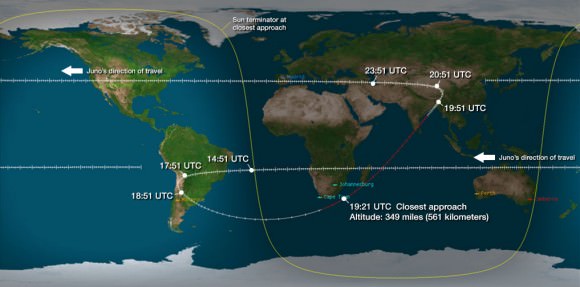
“The spacecraft is currently operating nominally and all systems are fully functional,” said the SwRI statement.
Although the Earth flyby did accomplish its primary goal of precisely targeting Juno towards Jupiter – within 2 kilometers of the aim point ! – the ship also suffered an unexplained anomaly that placed Juno into ‘safe mode’ at some point during the swoop past Earth.
“After Juno passed the period of Earth flyby closest approach at 12:21 PM PST [3:21 PM EDT] and we established communications 25 minutes later, we were in safe mode,” Juno Project manager Rick Nybakken, told me in a phone interview soon after Wednesday’s flyby of Earth. Nybakken is from NASA’s Jet Propulsion Lab in Pasadena, CA.
Nybakken also said that the probe was “power positive and we have full command ability.”
So the mission operations teams at JPL and prime contractor Lockheed Martin were optimistic about resolving the safe mode issue right from the outset.
“The spacecraft acted as expected during the transition into and while in safe mode,” acording to SwRI.
During the flyby, the science team also planned to observe Earth using most of Juno’s nine science instruments since the slingshot also serves as an important dress rehearsal and key test of the spacecraft’s instruments, systems and flight operations teams.
“The Juno science team is continuing to analyze data acquired by the spacecraft’s science instruments during the flyby. Most data and images were downlinked prior to the safe mode event.”
Juno’s closest approach took place over the ocean just off the tip of South Africa at about 561 kilometers (349 miles).
Juno launched atop an Atlas V rocket two years ago from Cape Canaveral Air Force Station, FL, on Aug. 5, 2011 on a journey to discover the genesis of Jupiter hidden deep inside the planet’s interior.
The $1.1 Billion Juno probe is continuing on its 2.8 Billion kilometer (1.7 Billion mile) outbound trek to the Jovian system.
During a one year long science mission – entailing 33 orbits lasting 11 days each – the probe will plunge to within about 3000 miles of the turbulent cloud tops and collect unprecedented new data that will unveil the hidden inner secrets of Jupiter’s origin and evolution.
“Jupiter is the Rosetta Stone of our solar system,” says Bolton. “It is by far the oldest planet, contains more material than all the other planets, asteroids and comets combined and carries deep inside it the story of not only the solar system but of us. Juno is going there as our emissary — to interpret what Jupiter has to say.”
Read more about Juno’s flyby in my articles – at NBC News; here, and Universe Today; here, here and here
NASA’s Juno Spacecraft Returns 1st Flyby images of Earth while Sailing On to Jupiter

Following the speed boosting slingshot of Earth on Wednesday, Oct. 9, that sent NASA’s Juno orbiter hurtling towards Jupiter, the probe has successfully transmitted back data and the very first flyby images despite unexpectedly going into ‘safe mode’ during the critical maneuver.
“Juno is transmitting telemetry today,” spokesman Guy Webster, of NASA’s Jet Propulsion Lab (JPL), told me in a phone interview late today (Oct. 10), as Juno continues sailing on its 2.8 Billion kilometer (1.7 Billion mile) outbound trek to the Jovian system.
The new images of Earth captured by the Junocam imager serves as tangible proof that Juno is communicating.
“Juno is still in safe mode today (Oct. 10),” Webster told Universe Today.
“Teams at mission control at JPL and Lockheed Martin are actively working to bring Juno out of safe mode. And that could still require a few days,” Webster explained.
Lockheed Martin is the prime contractor for Juno.
The initial raw images of Earth snapped by the craft’s Junocam imager were received by ground stations late today.
See above a day light image mosaic which I reconstructed and realigned based on the original raw image (see below) taken with the camera’s methane filter on Oct. 9 at 12:06:30 PDT (3:06:30 PM EST). Juno was to be flying over South America and the southern Atlantic Ocean.

Juno performed a crucial swingby of Earth on Wednesday that accelerated the probe by 16330 MPH to enable it to arrive in orbit around Jupiter on July 4, 2016.
However the gravity assist maneuver did not go entirely as planned.
Shortly after Wednesday’s flyby, Juno Project manager Rick Nybakken, of JPL, told me in a phone interview that Juno had entered safe mode but that the probe was “power positive and we have full command ability.”
“After Juno passed the period of Earth flyby closest approach at 12:21 PM PST [3:21 PM EDT] and we established communications 25 minutes later, we were in safe mode,” Nybakken explained.
The safe mode was triggered while Juno was in an eclipse mode, the only eclipse it will experience during its entire mission.
The Earth flyby did accomplish its objective by placing the $1.1 Billion Juno spacecraft exactly on course for Jupiter as intended.
“We are on our way to Jupiter as planned!”
“None of this affected our trajectory or the gravity assist maneuver – which is what the Earth flyby is,” Nybakken stated.
Juno’s closest approach was over South Africa at about 561 kilometers (349 miles).

During the flyby, the science team also planned to observe Earth using most of Juno’s nine science instruments since the slingshot also serves as a key test of the spacecraft systems and the flight operations teams.
Juno also was to capture an unprecedented new movie of the Earth/Moon system.
Many more images were snapped and should be transmitted in coming days that eventually will show a beautiful view of the Earth and Moon from space.
“During the earth flyby we have most of our instruments on and will obtain a unique movie of the Earth Moon system on our approach, Juno principal investigator Scott Bolton told me. Bolton is from the Southwest Research Institute (SwRI), San Antonio, Texas.
“We will also calibrate instuments and measure earth’s magnetosphere, obtain closeup images of the Earth and the Moon in UV [ultraviolet] and IR [infrared],” Bolton explained to Universe Today.
Juno is approaching the Earth from deep space, from the sunlit side.
“Juno will take never-before-seen images of the Earth-moon system, giving us a chance to see what we look like from Mars or Jupiter’” says Bolton.
Here is a description of Junocam from the developer – Malin Space Science Systems
“Like previous MSSS cameras (e.g., Mars Reconnaissance Orbiter’s Mars Color Imager) Junocam is a “pushframe” imager. The detector has multiple filter strips, each with a different bandpass, bonded directly to its photoactive surface. Each strip extends the entire width of the detector, but only a fraction of its height; Junocam’s filter strips are 1600 pixels wide and about 155 rows high. The filter strips are scanned across the target by spacecraft rotation. At the nominal spin rate of 2 RPM, frames are acquired about every 400 milliseconds. Junocam has four filters: three visible (red/green/blue) and a narrowband “methane” filter centered at about 890 nm.”
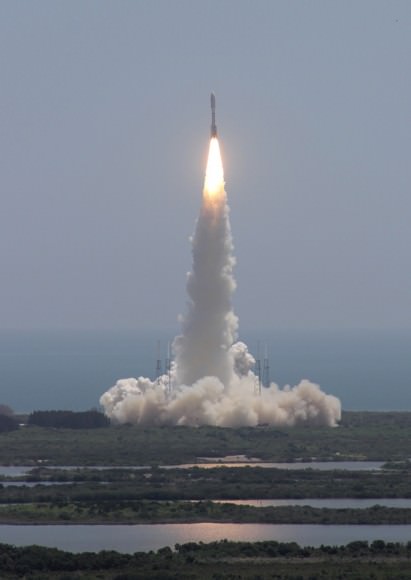
During a one year long science mission – entailing 33 orbits lasting 11 days each – the probe will plunge to within about 3000 miles of the turbulent cloud tops and collect unprecedented new data that will unveil the hidden inner secrets of Jupiter’s origin and evolution.
NBC News has also featured this Juno story – here
Read more about Juno’s flyby in my articles – here and here
Stay tuned here for continuing Juno, LADEE, MAVEN and more up-to-date NASA news.


